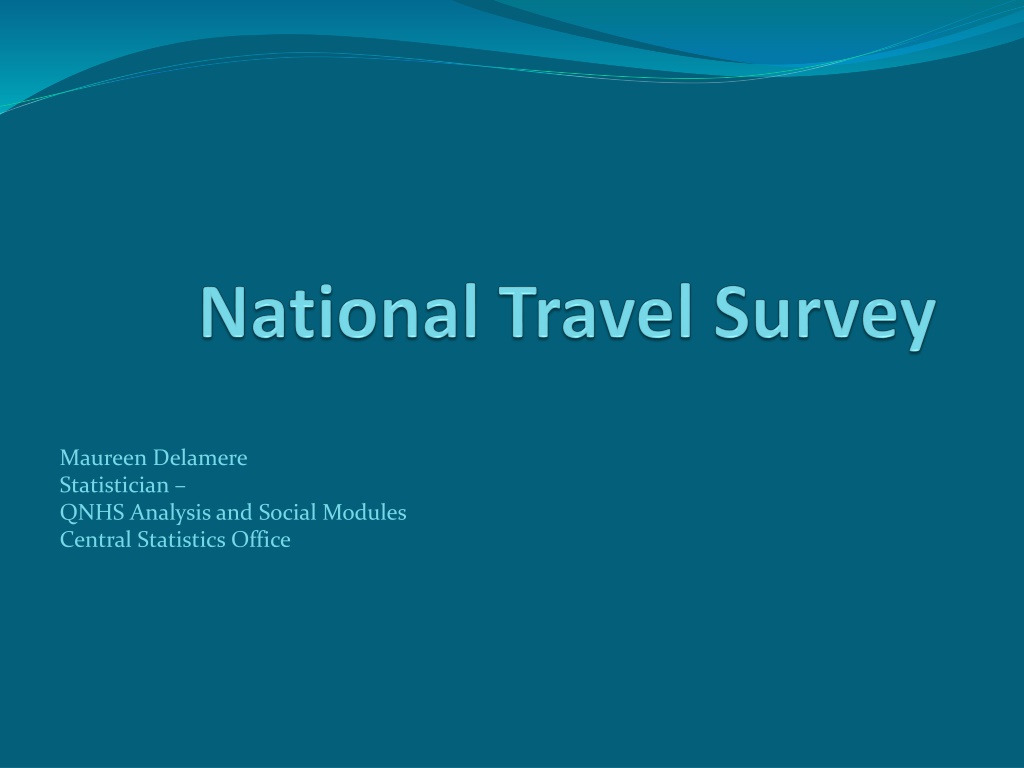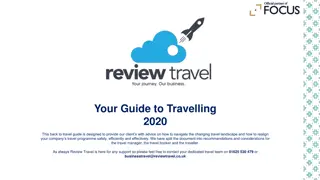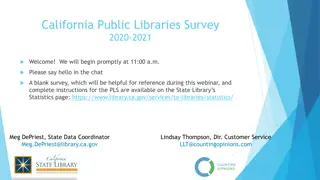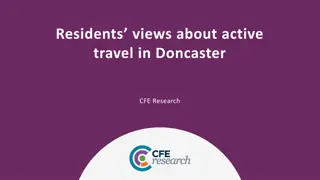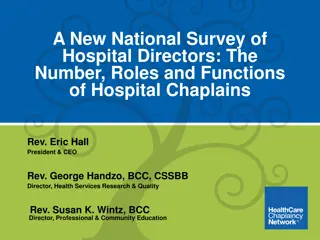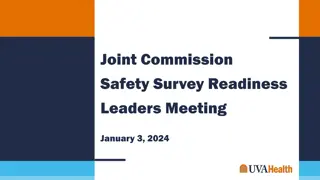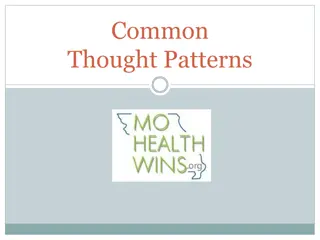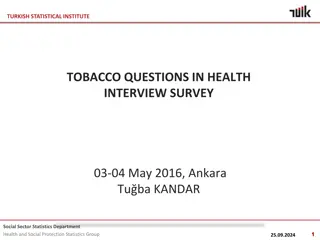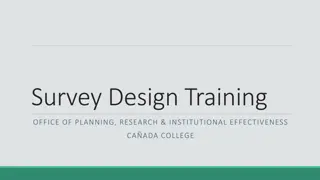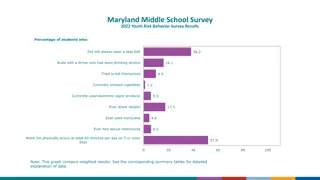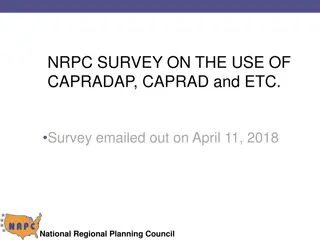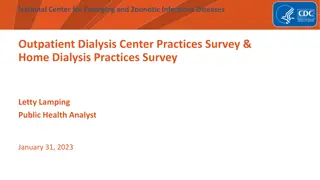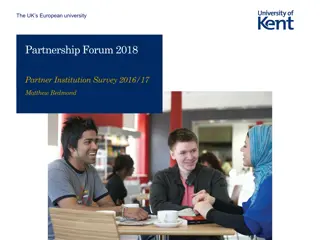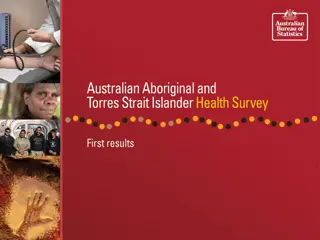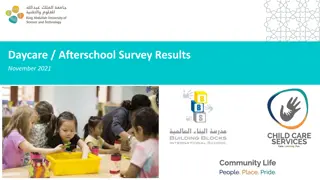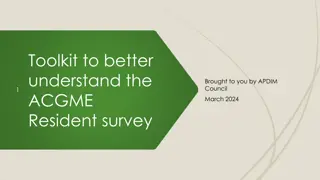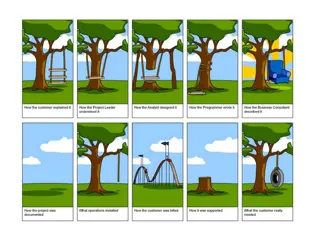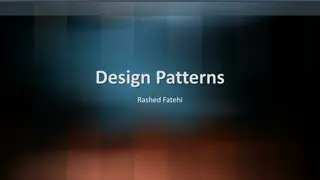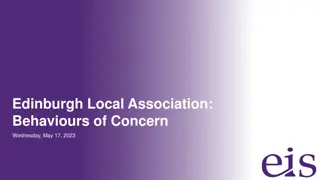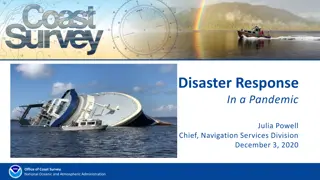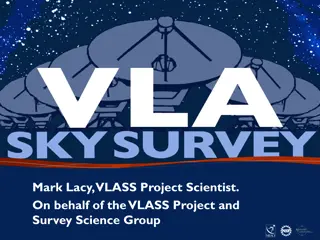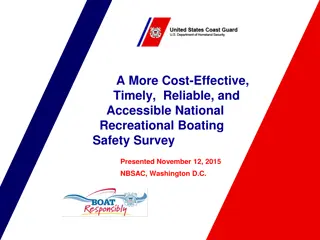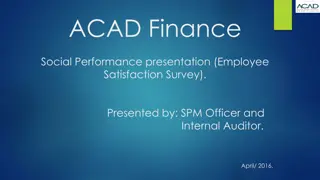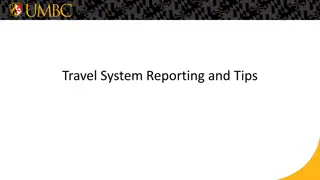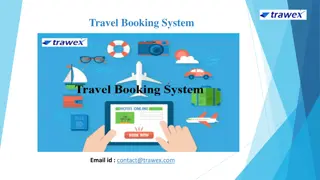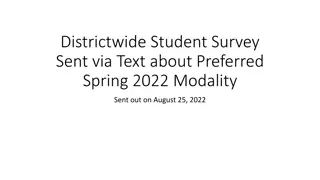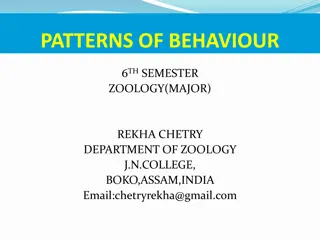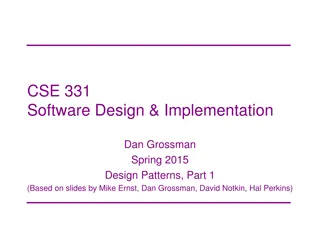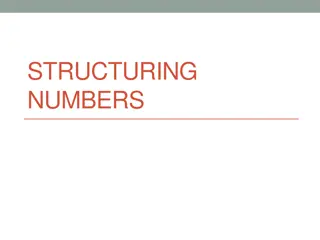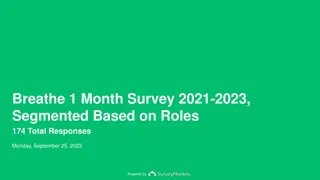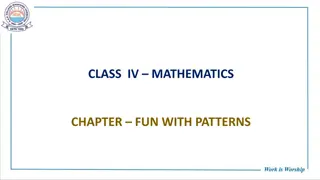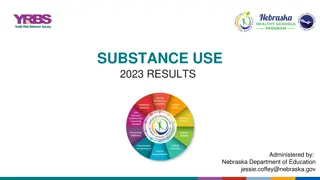National Travel Survey (NTS) Analysis: Insights on Travel Behavior and Patterns
The National Travel Survey (NTS) module of the QNHS provides detailed information on travel behavior collected from respondents within the State. It covers data on the number of journeys, reasons for travel, mode of transport, journey duration, and distance traveled. The survey is a comprehensive household study focusing on travel patterns, particularly within the island of Ireland. Care should be taken when interpreting the results, especially considering seasonality and the representativeness of quarterly data.
Download Presentation

Please find below an Image/Link to download the presentation.
The content on the website is provided AS IS for your information and personal use only. It may not be sold, licensed, or shared on other websites without obtaining consent from the author. Download presentation by click this link. If you encounter any issues during the download, it is possible that the publisher has removed the file from their server.
E N D
Presentation Transcript
Maureen Delamere Statistician QNHS Analysis and Social Modules Central Statistics Office
National Travel Survey (NTS) Module of QNHS Quarter 4 2009, 2012, 2013 and 2014 On travel behaviour of respondents One of most comprehensive household studies of travel patterns ever to be conducted within the State In 2014, detailed information on travel collected from 10,382 respondents comprising 18,031 journeys
NTS continued CAPI interviewing on waves 2 to 4 of QNHS sample The information collected included the following: number of journeys made reason for journey mode of transport used duration of each journey distance travelled Only travel within the island of Ireland, made by residents of the State
NTS continued 2011 Census of Population POWCAR (Place Of Work Census of Anonymised Records) POWCAR - definitive source of data on travel to work, school and college NTS results are for a particular quarter - may not be fully representative of the year as a whole Care should be taken when interpreting the results, especially if extrapolating to annualised results Also seasonality note of caution
NTS key definitions and descriptions Journey one way course of travel from A toB for the purpose of carrying out a specific activity at location B. Location could be a single premise or a complex of premises Return trips recorded as separate journeys Journeys must have: Commenced in the travel reference day (but may end the following day) Been at least 100 metres in length (approx one minute walk) Comprised exclusively of domestic travel (all stages of foreign travel were excluded) Not an integral part of respondent s routine employment Mode - where a journey consists of more than one mode of travel, the main mode of travel is the mode of travel used for greatest distance Travel reference period is 4am to 3:59am allows capture of information for respondents who finish work or return from leisure activities after midnight Data collected over 24 hour period
NTS key definitions and descriptions (continued) Travel Reference Day To ensure that data is collected for all 7 days of the week, each participant in the NTS is assigned a selected 'travel reference day - maximum of three days prior to the day of interview Wednesday through to Saturday interviews - travel reference day was the immediately preceding day Monday interviews - .30% of Monday interviews were assigned at random to the immediately preceding Friday, 42% to the immediately preceding Saturday and 28% to the immediately preceding Sunday. Tuesday interviews- 17% were assigned at random to the immediately preceding Sunday and 83% were assigned to the immediately preceding Monday Excluded the business related travel of professional drivers (e.g. bus and taxi drivers) and other occupations where travel is integral to the role (e.g. postal delivery workers) NTS journey purpose of 'work' includes both commuter and business travel Excludes the business related travel of professional drivers (e.g. bus and taxi drivers) and other occupations where travel is integral to the role (e.g. postal delivery workers)
Users of NTS Data Used to compile statistical indicators for journey purpose and modes of travel Universally accepted necessity for better transport data to underpin transport policy making and monitoring of key programmes, including Smarter Travel Help monitor implementation of existing transport policy and will inform future transport initiatives With regular surveys any shifts will be detected earlier and allow policy approaches to be more responsive in future Help monitor implementation of existing transport policy and will inform future transport initiatives Measure of demand for personal transport within the State Spending on Transport in 2014 was 1.1 billion
Percentage of persons who travelled on the travel reference day Figure 1 Percentage of persons who travelled and did not travel on the travel reference day, 2012, 2013 and 2014 2014 2013 2012 0 20 40 60 80 100 Travelled Did not travel
Percentage of persons who travelled by region (NUTS3) Figure 2 Percentage of persons who travelled on the travel reference day by region, 2012, 2013 and 2014 % of persons 80 60 40 20 0 2012 2013 2014
Percentage distribution of journeys by purpose Figure 3 Percentage distribution of journeys by purpose, 2012 , 2013 and 2014 2012 2.3 10.5 9.1 5.8 19.0 4.1 23.0 4.8 21.4 2013 1.9 10.2 9.8 6.4 15.2 4.2 24.8 4.6 22.7 2014 1.8 10.8 9.9 5.2 13.8 5.1 25.0 4.5 24.0 0% 10% 20% 30% 40% 50% 60% 70% 80% 90% 100% Purpose Work Education Shopping To eat or drink Visit family / friends Entertainment / leisure / sports Personal business Companion / escort journey Other
Percentage distribution of journeys by time of departure Figure 4 Percentage distribution of journeys by time of departure, 2012, 2013 and 2014 2012 23.9 23.3 11.8 19.9 19.4 1.7 2013 22.9 23.6 15.9 4.1 14.9 18.6 2014 22.0 24.0 13.2 2.5 18.6 19.7 0% 10% 20% 30% 40% 50% 60% 70% 80% 90% 100% Time of departure 00:00-06:59 07:00-09:59 10:00-12:59 13:00-15:59 16:00-18:59 19.00-23:59
Percentage distribution of journeys by duration Figure 5 Percentage distribution of journeys by duration, 2012 , 2013 and 2014 2012 4.2 3.9 27.5 6.7 57.6 2013 4.5 4.3 57.6 26.6 7.0 2014 4.9 4.5 56.9 26.4 7.3 0% 10% 20% 30% 40% 50% 60% 70% 80% 90% 100% Duration 15 minutes or less 16 - 30 minutes 31 - 45 minutes 46 - 60 minutes >60 minutes
Percentage distribution of journeys by journey distance Figure 6 Percentage distribution of journeys by journey distance, 2012 , 2013 and 2014 2012 6.0 41.9 18.2 11.7 22.3 2013 6.6 41.7 21.1 18.9 11.7 2014 6.4 41.9 18.8 20.0 13.0 0% 10% 20% 30% 40% 50% 60% 70% 80% 90% 100% Distance <2 kilometres 2<4 kilometres 4<6 kilometres 6<8 kilometres 8+ kilometres
Percentage distribution of journeys by mode of travel and degree of urbanisation Figure 7 Percentage distribution of journeys by mode of travel and degree of urbanisation, 2014 Densely populated 66.2 5.1 15.1 6.3 2.2 2.3 1.0 1.9 Intermediate density 70.8 5.3 15.0 2.5 1.3 0.4 0.9 3.7 Thinly populated 73.1 5.8 14.1 2.3 0.9 0.3 0.8 2.7 0% 10% 20% 30% 40% 50% Mode of travel 60% 70% 80% 90% 100% Private car - Driver Private car - Passenger Walk Bus Cycle Rail/Dart/Luas Taxi/hackney Lorry/Motorcycle/Other
Percentage distribution of journeys by mode of travel Figure 8 Percentage distribution of journeys by mode of travel, 2012, 2013 and 2014 100% 1.4 1.3 1.5 1.2 0.8 1.3 0.9 1.6 0.9 3.9 3.8 4.4 90% 13.6 15.4 14.8 80% 6.1 5.3 5.8 70% 60% 50% 40% 70.4 69.1 69.0 30% 20% 10% 0% 2014 2013 Mode 2012 Private car - driver Private car - passenger Walk Bus Cycle Rail/DART/Luas Taxi/hackney Lorry/motorcycle/other
Mode of travel Percentage distribution of journeys by mode of travel 2014 Dublin region All regions excluding Dublin 0.90.5 1.2 0.8 3.4 1.5 2.3 3.0 3.3 9.1 Private car - Driver 13.2 Private car - Passenger Walk 5.5 Bus Cycle 18.6 Rail/Dart/Luas Taxi/hackney 58.1 73.9 Lorry/Motorcycle/Other 4.9
Figure 9 Percentage distribution of journeys by mode of travel and duration, 2014 100% 3.1 3.2 3.6 4.0 5.6 0.2 1.5 2.0 3.8 1.9 4.5 1.9 1.4 4.9 1.6 90% 5.5 1.9 10.2 16.0 11.6 10.4 80% 15.3 4.5 8.0 7.1 15.8 70% 5.4 6.9 10.1 7.6 60% 50% 40% 72.8 66.2 63.5 30% 60.1 58.0 20% 10% 0% 15 minutes or less 16 - 30 minutes 31 - 45 minutes 46 - 60 minutes >60 minutes Private car - Driver Private car - Passenger Walk Bus Cycle Rail/Dart/Luas Taxi/hackneyLorry/Motorcycle/Other
Figure 10 Percentage distribution of journeys by mode of travel and distance, 2014 100% 2.0 2.3 3.7 3.8 0.0 4.4 0.5 1.6 1.0 0.8 2.7 1.8 2.6 2.5 2.4 0.7 4.1 90% 6.1 5.2 6.3 0.9 5.8 7.9 11.4 80% 21.4 4.5 44.1 4.9 70% 3.3 60% 2.2 50% 40% 78.3 75.4 70.6 65.6 30% 49.1 20% 10% 0% < 2 kilometres 2<4 kilometres 4<6 kilometres 6<8 kilometres 8+ kilometres Private car - Driver Private car - Passenger Walk Bus Cycle Rail/Dart/Luas Taxi/hackneyLorry/Motorcycle/Other
Those who did not travel Figure 20 Reasons for not travelling, 2014 6.6 2.5 6.2 Had no wish or need to travel / fully occupied with home duties 1.5 Short term illness 2.4 Long term illness / mobility impairment No access to transport 5.8 Cost The weather 8.8 Travelling abroad 66.0 Other
Those who did travel by travel group size Figure 11 Percentage distribution of travel group size, 2014 2.4 4.4 7.9 Solo journey Two person journey Three person journey 22.5 Four person journey 62.9 5+ person journey
Figure 12 Percentage distribution of journeys by purpose and degree of urbanisation, 2014 Densely populated 25.7 4.0 24.0 1.7 10.8 10.4 4.4 14.2 4.9 Intermediate density 25.1 4.6 22.9 2.0 11.8 8.5 5.8 14.5 4.7 Thinly populated 23.6 5.4 24.8 1.8 10.0 10.1 6.0 12.4 5.9 0% 10% 20% 30% 40% 50% 60% 70% 80% 90% 100% Purpose Work Education Shopping To eat or drink Visit family / friends Entertainment / leisure / sports Personal business Companion / escort journey Other
Figure 13 Percentage distribution of journey purpose by distance, 2014 <2 kms 15.2 5.1 31.4 2.7 9.3 8.1 4.4 18.8 4.9 2<4 kms 20.3 6.3 29.3 2.0 7.1 9.3 3.9 16.9 4.9 4<6 kms 21.8 5.0 23.9 2.2 9.8 13.1 5.5 13.9 4.8 6<8 kms 22.6 4.9 20.9 1.1 11.6 10.3 4.9 17.1 6.7 8+ kms 33.4 3.2 18.3 1.2 13.5 9.9 6.0 9.3 5.2 0% 10% 20% 30% 40% 50% 60% 70% 80% 90% 100% Purpose Work Shopping Visit family / friends Personal business Other Education To eat or drink Entertainment / leisure / sports Companion / escort journey
Figure 13 Percentage distribution of journey purpose by duration, 2014 15 mins or less 20.2 4.4 28.9 2.2 9.3 7.8 5.1 17.8 4.4 16-30 mins 30.1 4.5 20.6 1.3 12.0 12.0 4.7 9.9 5.0 31-45 mins 41.1 6.3 13.5 1.7 11.2 10.5 4.3 6.2 5.2 46-60 mins 28.1 4.9 12.9 0.6 14.9 18.1 5.8 4.2 10.4 >60 mins 28.1 3.1 8.3 0.5 18.3 15.5 9.3 7.7 9.2 0% 10% 20% 30% 40% 50% 60% 70% 80% 90% 100% Purpose Work Shopping Visit family / friends Personal business Other Education To eat or drink Entertainment / leisure / sports Companion / escort journey
Figure 15 Percentage distribution of journeys by purpose and by mode for all regions excluding Dublin, 2014 Private car 26 3 24 1 11 8 6 16 5 Public transport 20 13 26 3 12 8 9 3 6 Walk/cycle 14 11 24 4 10 17 4 9 7 Lorry/motorcycle/ other 53 1 11 4 7 7 8 4 7 0% 10% 20% 30% 40% 50% 60% 70% 80% 90% 100% Purpose Work Education Shopping To eat or drink Visit family / friends Entertainment / leisure / sports Personal business Companion / escort journey Other
Figure 16 Percentage distribution of journey duration for Dublin versus all regions excluding Dublin, 2014 100% 49.6 60.1 90% 80% 70% 60% 50% 32.5 40% 23.7 30% 20% 9.2 6.5 10% 4.9 4.9 3.8 4.9 0% Dublin All regions excluding Dublin >60 minutes 46 - 60 minutes 31 - 45 minutes 16 - 30 minutes 15 minutes or less
Figure 17 Percentage distribution of journey distance for Dublin versus all regions excluding Dublin, 2014 100% 33.8 45.4 90% 80% 70% 8.1 60% 15.8 5.6 50% 11.7 40% 22.8 18.8 30% 20% 18.5 19.5 10% 0% Dublin All regions excluding Dublin <2 kilometres 2<4 kilometres 4<6 kilometres 6<8 kilometres 8+ kilometres
Figure 18 Percentage distribution of journey duration by mode, 2014 15 mins or less 2 73 5 16 2 0 3 16-30 mins 6 66 5 15 2 2 4 31-45 mins 12 64 7 8 2 5 4 46-60 mins 10 58 8 16 1 4 3 >60 mins 10 60 10 7 2 5 6 0% 10% 20% 30% 40% 50% 60% 70% 80% 90% 100% Private car - Driver Private car - Passenger Walk Bus Cycle Rail/Dart/Luas Taxi/hackneyLorry/Motorcycle/Other
Future of NTS Next survey Quarter 4 2016 No change basis Household Survey Development Project transformation programme for QNHS CSO - meet user demand for travel data while simultaneously reducing the response burden, minimising the required inputs Does the change being captured by the survey necessitate an annual survey?
Thank you for your time Any questions?
